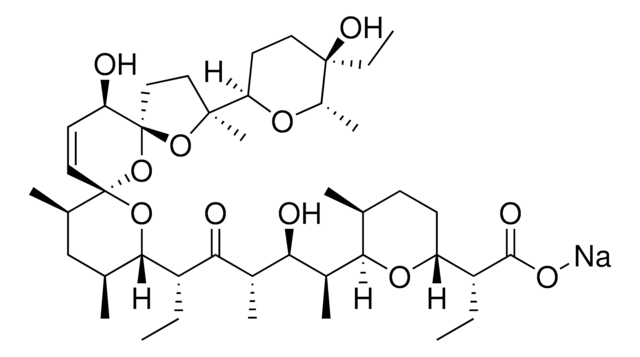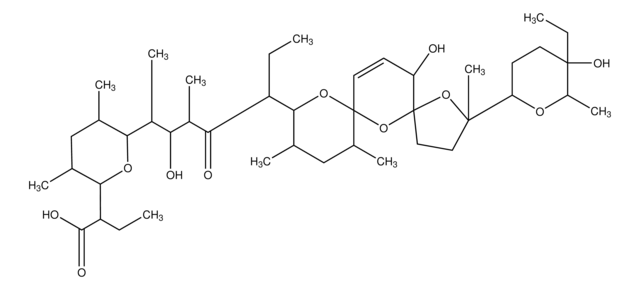M5273
Monensin sodium salt
90-95% (TLC)
Synonim(y):
Monensin A sodium salt
About This Item
Polecane produkty
Próba
90-95% (TLC)
spektrum działania antybiotyku
Gram-negative bacteria
Gram-positive bacteria
fungi
parasites
viruses
Tryb działania
cell membrane | interferes
temp. przechowywania
2-8°C
ciąg SMILES
[H][C@]1([C@@]2(CC)O[C@]([C@@]3(C)OC4(C[C@H](O)[C@@H](C)[C@@]([H])([C@@H](C)[C@@H](OC)[C@@H](C([O-])=O)C)O4)CC3)([H])CC2)[C@@H](C)C[C@]([H])([C@@]5([H])O[C@@](O)(CO)[C@H](C)C[C@@H]5C)O1.[Na+]
InChI
1S/C36H62O11.Na/c1-10-34(31-20(3)16-26(43-31)28-19(2)15-21(4)36(41,18-37)46-28)12-11-27(44-34)33(8)13-14-35(47-33)17-25(38)22(5)30(45-35)23(6)29(42-9)24(7)32(39)40;/h19-31,37-38,41H,10-18H2,1-9H3,(H,39,40);/q;+1/p-1/t19-,20-,21+,22+,23-,24-,25-,26+,27+,28-,29+,30-,31+,33-,34-,35?,36-;/m0./s1
Klucz InChI
XOIQMTLWECTKJL-BEMBKCOJSA-M
Szukasz podobnych produktów? Odwiedź Przewodnik dotyczący porównywania produktów
Opis ogólny
Zastosowanie
- for the intracellular staining of cytokines
- to study its effects on the regulation of nuclear factor-κ B (NF-κB ) activation
- as a positive control to study its effects on in vitro rumen fermentation
Działania biochem./fizjol.
Uwaga dotycząca przygotowania
Hasło ostrzegawcze
Danger
Zwroty wskazujące rodzaj zagrożenia
Zwroty wskazujące środki ostrożności
Klasyfikacja zagrożeń
Acute Tox. 2 Oral - Aquatic Chronic 2 - Eye Irrit. 2 - STOT RE 2
Organy docelowe
Heart,muscle
Kod klasy składowania
6.1A - Combustible acute toxic Cat. 1 and 2 / very toxic hazardous materials
Klasa zagrożenia wodnego (WGK)
WGK 3
Temperatura zapłonu (°F)
Not applicable
Temperatura zapłonu (°C)
Not applicable
Środki ochrony indywidualnej
Eyeshields, Faceshields, Gloves, type P2 (EN 143) respirator cartridges
Certyfikaty analizy (CoA)
Poszukaj Certyfikaty analizy (CoA), wpisując numer partii/serii produktów. Numery serii i partii można znaleźć na etykiecie produktu po słowach „seria” lub „partia”.
Masz już ten produkt?
Dokumenty związane z niedawno zakupionymi produktami zostały zamieszczone w Bibliotece dokumentów.
Klienci oglądali również te produkty
Nasz zespół naukowców ma doświadczenie we wszystkich obszarach badań, w tym w naukach przyrodniczych, materiałoznawstwie, syntezie chemicznej, chromatografii, analityce i wielu innych dziedzinach.
Skontaktuj się z zespołem ds. pomocy technicznej












